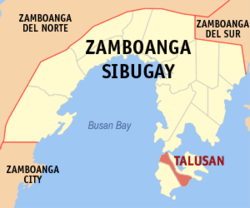Talusan | |
|---|---|
| Municipality of Talusan | |
 Map of Zamboanga Sibugay with Talusan highlighted | |
Location within the Philippines | |
| Coordinates: 7°25′35″N122°48′30″E / 7.426311°N 122.808403°E | |
| Country | Philippines |
| Region | Zamboanga Peninsula |
| Province | Zamboanga Sibugay |
| District | 1st district |
| Founded | November 11, 1977 |
| Barangays | 14 (see Barangays) |
| Government | |
| • Type | Sangguniang Bayan |
| • Mayor | Gilbert Edem |
| • Vice Mayor | Orlando Ramiso |
| • Representative | Wilter W. Palma II |
| • Municipal Council | Members |
| • Electorate | 11,140 voters (2025) |
| Area | |
• Total | 58.16 km2 (22.46 sq mi) |
| Elevation | 7.0 m (23.0 ft) |
| Highest elevation | 45 m (148 ft) |
| Lowest elevation | −3 m (−10 ft) |
| Population (2024 census) [3] | |
• Total | 17,925 |
| • Density | 310/km2 (800/sq mi) |
| • Households | 5,495 |
| Economy | |
| • Income class | 5th municipal income class |
| • Poverty incidence | 39.44 |
| • Revenue | ₱ 144.3 million (2022) |
| • Assets | ₱ 451.4 million (2022) |
| • Expenditure | ₱ 109.4 million (2022) |
| • Liabilities | ₱ 75.72 million (2022) |
| Service provider | |
| • Electricity | Zamboanga del Sur 2 Electric Cooperative (ZAMSURECO 2) |
| Time zone | UTC+8 (PST) |
| ZIP code | 7012 |
| PSGC | |
| IDD : area code | +63 (0)62 |
| Native languages | Subanon Cebuano Chavacano Tagalog |
| Website | www |
Talusan, officially the Municipality of Talusan (Cebuano : Lungsod sa Talusan; Chavacano: Municipalidad de Talusan; Tagalog : Bayan ng Talusan), is a municipality in the province of Zamboanga Sibugay, Philippines. According to the 2020 census, it has a population of 27,873 people. [5]
Contents
It is the second least populous municipality in the province and the smallest in area.
The municipality is located in the central part of Olutanga Island.


